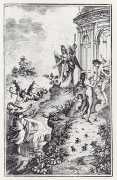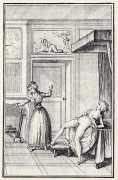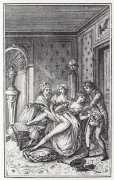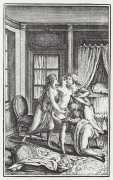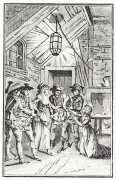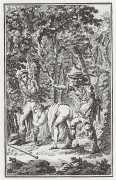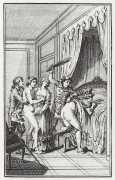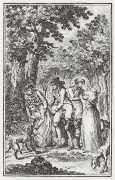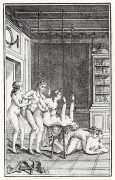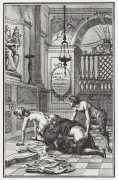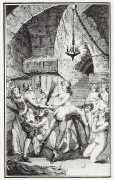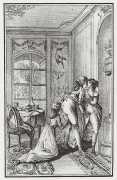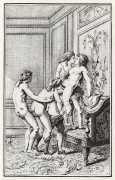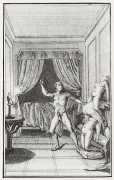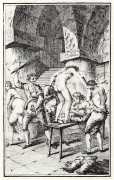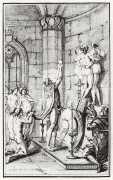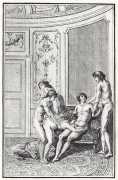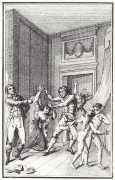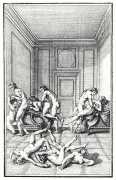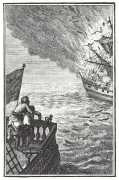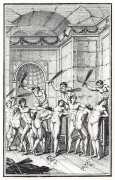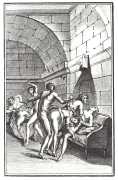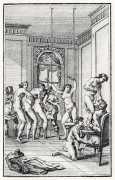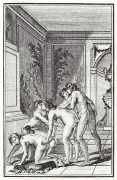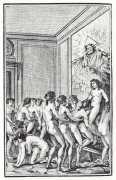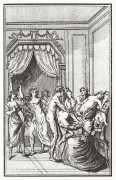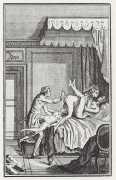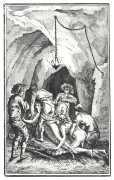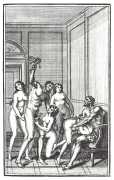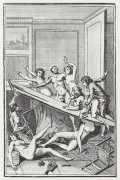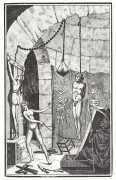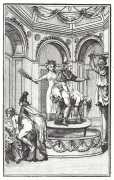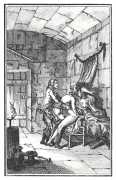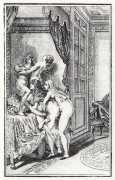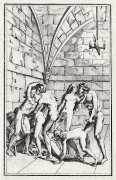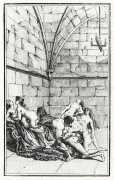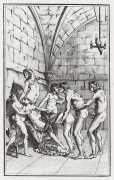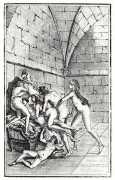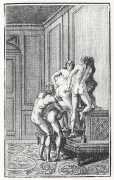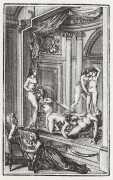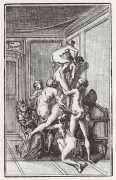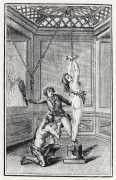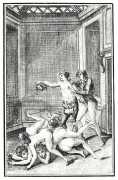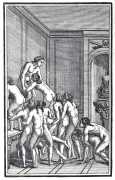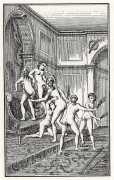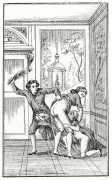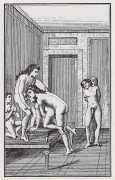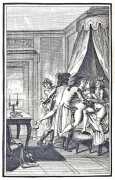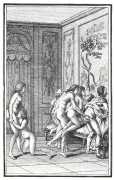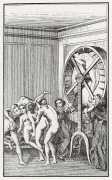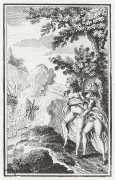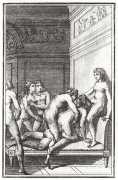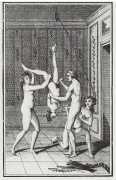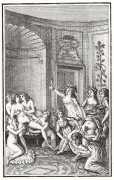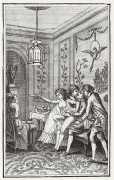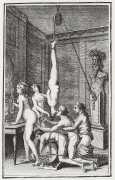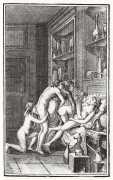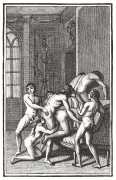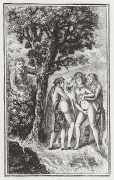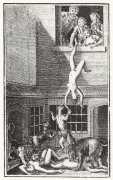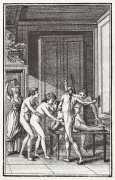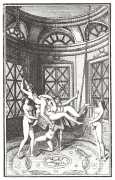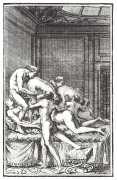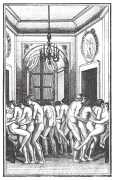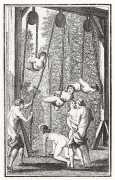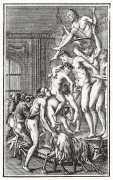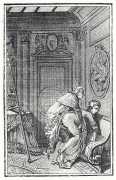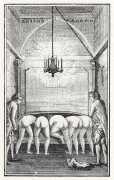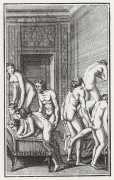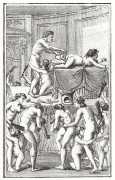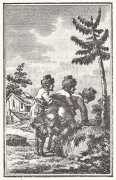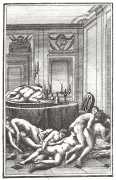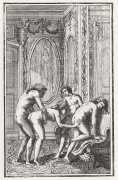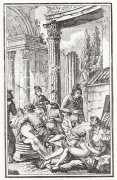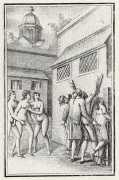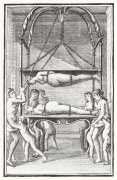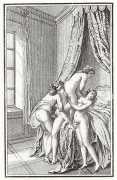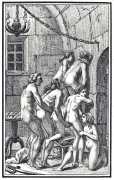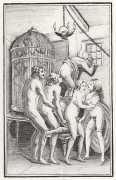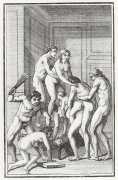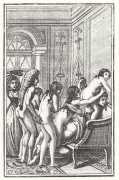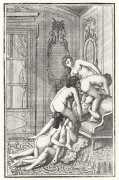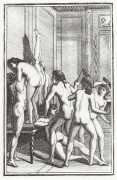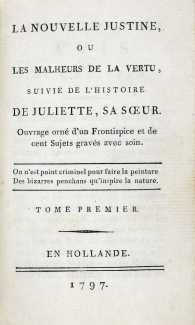 Claude Bornet was fortunate to have been a contemporary of Donatien Alphonse François de Sade, better known as the Marquis de Sade, and when he was commissioned to illustrate de Sade’s work he clearly relished the opportunity.
Claude Bornet was fortunate to have been a contemporary of Donatien Alphonse François de Sade, better known as the Marquis de Sade, and when he was commissioned to illustrate de Sade’s work he clearly relished the opportunity.
Sade wrote the first, and shortest, version of Justine’s story, Les infortunes de la vertu, in just two weeks in 1787, during his imprisonment in the Bastille. During the following months, he was already working on revising and augmenting the conte into the full-fledged novel, Justine, ou les malheurs de la vertu (Justine, or The Misfortunes of Virtue), which was published anonymously in 1791. Subsequently, Sade expanded the account of Justine’s tribulations still further, until it became the first part of his sulphurous epic La nouvelle Justine, ou les malheurs de la vertu, suivie de l’histoire de Juliette, sa sœur, ou les prospérités du vice (The New Justine, or The Misfortunes of Virtue, followed by the Story of Juliette, her Sister, or The Prosperities of Vice), published anonymously in 1797, with a hundred engravings and a frontispiece executed from drawings attributed to Bornet.
In the 1787 and 1791 narratives, on her way to the scaffold after being unjustly convicted of theft, murder and arson, the virtuous and most unfortunate Justine encounters the Comtesse de Lorsange. Using the alias Sophie (in Les infortunes) or Thérèse (in Justine), she recounts the sad events of her life to the comtesse, and the two women realise that they are the long-separated sisters Justine and Juliette. In Les infortunes, Justine’s abusers include a parish priest; a miser; the criminal Mme Dubois and her highwaymen confederates; the atheist, matricidal sodomite Marquis de Bressac; a vivisectionist surgeon; the debauched monks at the convent of Sainte-Marie-des-Bois; and a slave-driving counterfeiter. In Justine, to this group are added – among others – a devious merchant, the gluttonous and vampiric Comte de Gernande, and a nameless nobleman who likes to decapitate his young female victims. In La nouvelle Justine we find still more villains, including a reclusive vegetarian who impregnates women so he can drown their babies, and a band of cave-dwelling beggars and thieves.
L’histoire de Juliette is peopled by an even larger gallery of vicious libertines, and the stage for their activities expands to include England, Sweden, Italy, Russia and Turkey, as well as France. Juliette’s mentors, associates and disciples in violent debauchery range from adventurers and criminals of various sorts to noblemen and women and high-ranking officials, to clerics (nuns, monks, bishops, cardinals, and even a completely fictionalised pope), to dukes and duchesses, princes and princesses, and monarchs including Catherine the Great. Notable among them are the powerful and black-hearted Noirceuil and Saint-Fond, the equally monstrous Mme de Clairwil, the sorceress La Durand, and the cannibalistic Russian ogre Minski. Many of the exploits of the libertines in both La nouvelle Justine and L’histoire de Juliette are depicted in the images presented here. The illustrations are explicitly graphic in their depictions of every kind of transgressive sex, including homosexuality and lesbianism, orgies, flogging and torture, bestiality and paedophilia.
In all three of her incarnations, Justine is killed by a bolt of lightning. In Les infortunes and Justine, her fate causes Juliette to repent for her many sins and enter a convent. At the end of La nouvelle Justine, however, vice is triumphant – after Juliette compels Justine to listen to the account of her obscene adventures, she and her companions deliberately cast Justine out into the storm and are overjoyed to witness her death.
La nouvelle Justine, ou les malheurs de la vertu, suivie de l’histoire de Juliette, sa sœur, ou les prospérités du vice was published ‘en Hollande’ (though probably in fact in Paris) in ten volumes. Justine’s story comprises the first four volumes, and Juliette’s the last six.
We are very grateful to our Texan colleague Phyllis Eccleston for the research and images presented here.


